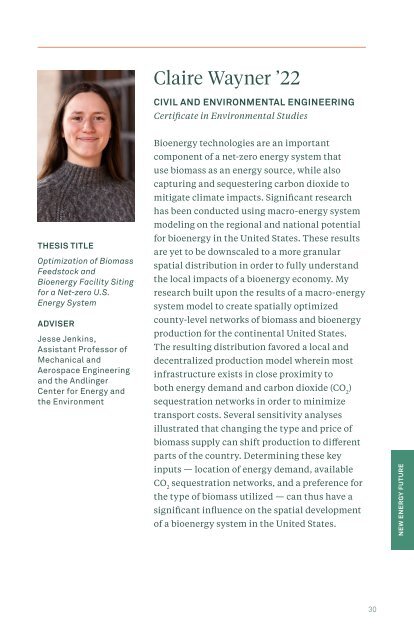Undergraduate Research: An Archive - 2022 Program
You also want an ePaper? Increase the reach of your titles
YUMPU automatically turns print PDFs into web optimized ePapers that Google loves.
Claire Wayner ’22<br />
CIVIL AND ENVIRONMENTAL ENGINEERING<br />
Certificate in Environmental Studies<br />
THESIS TITLE<br />
Optimization of Biomass<br />
Feedstock and<br />
Bioenergy Facility Siting<br />
for a Net-zero U.S.<br />
Energy System<br />
ADVISER<br />
Jesse Jenkins,<br />
Assistant Professor of<br />
Mechanical and<br />
Aerospace Engineering<br />
and the <strong>An</strong>dlinger<br />
Center for Energy and<br />
the Environment<br />
Bioenergy technologies are an important<br />
component of a net-zero energy system that<br />
use biomass as an energy source, while also<br />
capturing and sequestering carbon dioxide to<br />
mitigate climate impacts. Significant research<br />
has been conducted using macro-energy system<br />
modeling on the regional and national potential<br />
for bioenergy in the United States. These results<br />
are yet to be downscaled to a more granular<br />
spatial distribution in order to fully understand<br />
the local impacts of a bioenergy economy. My<br />
research built upon the results of a macro-energy<br />
system model to create spatially optimized<br />
county-level networks of biomass and bioenergy<br />
production for the continental United States.<br />
The resulting distribution favored a local and<br />
decentralized production model wherein most<br />
infrastructure exists in close proximity to<br />
both energy demand and carbon dioxide (CO 2<br />
)<br />
sequestration networks in order to minimize<br />
transport costs. Several sensitivity analyses<br />
illustrated that changing the type and price of<br />
biomass supply can shift production to different<br />
parts of the country. Determining these key<br />
inputs — location of energy demand, available<br />
CO 2<br />
sequestration networks, and a preference for<br />
the type of biomass utilized — can thus have a<br />
significant influence on the spatial development<br />
of a bioenergy system in the United States.<br />
NEW ENERGY FUTURE<br />
30
















